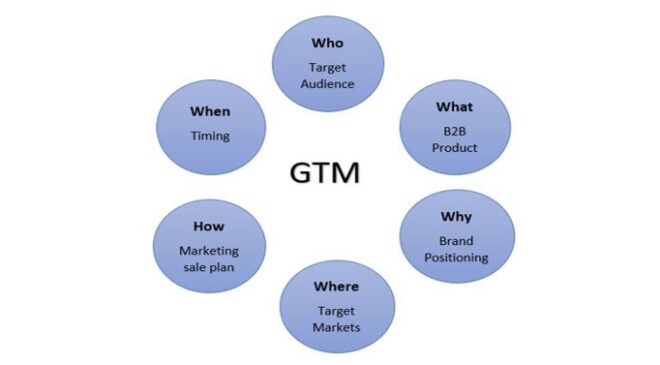Shirofune Enhances Shopify Integration with Google Analytics 4’s Data-Driven Attribution Model
Go-To-Market Strategy

What Is a Go-To-Market Strategy?
A go-to-market (GTM) strategy is a strategy that assists you in defining your ideal customers, coordinating your messaging, and positioning your product for launch. A GTM approach also puts critical business units on the same page, allowing you to satisfy a market need while iterating on your product successfully. Developing a go-to-market strategy is as critical for established businesses as it is for start-ups. This post will teach you more about the purpose of GTM techniques, show you instances of them in action, and show you how to construct your own. The go-to-market strategy solves three key questions: who the customers are, what the offering is, and how to reach the target customers in a scalable and repeatable manner.
A go-to-market strategy, in simple terms, is an explanation of how the product will be supplied to clients. A go-to-market strategy can help businesses in the following ways: it can minimize time to market, save money on failed product launches, give a great customer experience, clarify the objective, and ensure a successful product launch. Furthermore, the GTM strategy reduces client acquisition expenses, enhances the company’s capacity to deal with obstacles, guides the team throughout the process, and establishes a route for growth. To create an effective GTM strategy, you must engage with your consumers, run a mission-driven business, and stay ahead of the competition. As a result, an effective go-to-market strategy consists of three C’s: Customers, Company, and Competitors.
Why do you need a go-to-market strategy?
GTM strategies offer businesses the knowledge they need to properly position themselves against competitors, build scalable inbound and outbound models, and employ appropriate approaches to achieve their objectives. Launches typically fail when corporations presume a product’s market necessity and spend on its development without first acquiring this knowledge.
What are the different types of go-to-market strategies?
The two basic categories of GTM strategy are product-led and sales-led.
- Product-led: A product-led GTM strategy acquires and retains consumers through the product itself. The product acts as a salesperson in this method by giving so much value that the user is compelled to upgrade their bundle. Calendly and Slack are excellent instances of product-led growth at work.
- Sales-led: A sales-led GTM strategy, on the other hand, employs marketing to generate interest in a product, which is then captured in content and demo formats. Salespeople then contact such prospects to turn them into clients. Cognism, like many other B2B SaaS startups, takes this strategy.

However, today, businesses prefer to be a little more specific than that. To elaborate, all go-to-market strategies have the following core components:
- Target Market – Before you do anything else, you should define your target audience. This includes demographic, psychographic, geographical, and other factors that can assist you in narrowing your focus. Additionally, you’ll need to construct buyer personas and identify the best profiles to target more on that later.
- Value Proposition and Product Messaging – Another important component of your GTM approach is your value proposition and a clear description of your product (the problems it solves, for example). These will assist you in positioning your brand and making it stand out from the crowd.
- Pricing Strategy – Choose a suitable price strategy based on your target market and positioning objectives.
- Distribution Plan – Finally, ensure that you have a solid distribution strategy in place for your new product.
How to Create a GTM Strategy
You can’t rush the planning and implementation of your GTM strategy if you want to achieve a good product-market fit. While the finer details will differ, there are some steps that anyone can follow to create a go-to-market strategy from the beginning.
1. Describe Your Target Market and Create Buyer Personas
Begin with the fundamentals. You must have considered the pain points that your solution will alleviate when developing the concept. The basic definition of your target market is next on the list. Begin by asking broad questions, then restrict your focus, as follows (in order): Who will be affected by the problem(s) that my product will solve? What demographic characteristics define them? Are there any psychological or geographical elements at work here? What other variables, if any, would you include in your market definition? This will help you target the right people. Create buyer personas if you’re in the B2B industry (such as a SaaS provider). To explain the value offered to your stakeholders, develop a value matrix by assigning a pain issue and a product message to each buyer persona. Here’s an example from Sales Hero:
2. Craft the Rest of Your Basic Marketing Strategy
I say “the rest” since your target market definition, customer personas, and product message are all part of your core marketing plan. With that out of the way, it’s time to turn our attention to other issues, such as:
- Marketing Tactics – Will you utilize outbound tactics, inbound approach, or a combination of both based on your product? Taking advantage of content marketing, SEO, and other methods while also engaging in paid channels and interruptive tactics such as display ads, print, cold calls, and so on is usually the best option.
- Positioning – What do you want people to think about your product? Find a way to set yourself apart from the competition in the market.
- Branding – Determine your product’s personality. Determine the language you want to use, the color you want to use, and the values and promises you want to communicate using your target market as a guide.
Last but not least, remember to establish clear marketing objectives and grasp various SaaS metrics, as these can assist you in navigating and measuring the effectiveness of your efforts.
3. Determine the Pricing Strategy
Decide on an acceptable price plan with the help of your marketing and finance departments. Consider the market you’re targeting and your value proposition while developing your price plan. You may always use the good ol’ pricing matrix to help you decide: You can use “fewer” or “restricted” features for “poor quality.” Because, let’s face it, no one wants to purchase a low-quality item these days. Create an acceptable pricing strategy while keeping this in mind, as well as your marketing objectives. Another safe approach is to look at your competitors’ prices and see if you can match them, provide a better deal over time, or even go with value-based pricing.
4. Create Your Sales Strategy
With your marketing strategy and pricing strategy in place, it’s time to synchronize your sales approach. Since we’ve previously covered marketing and promotion, the only thing left to do is figure out how you’re going to sell your goods. What mediums will you use to offer your goods, depending on their nature, type, and market? For example, if you’re a SaaS company offering cloud-based solutions, you may just go online. On-site solutions and real items, on the other hand, will necessitate a more hands-on and physical approach. You will also need to supply training and support materials to your sales team (if any).
5. Set Up Customer Support
Excellent customer service is no longer a differentiator, but rather a requirement for all businesses. As a result, you’ll need to provide excellent technical support to your clients both during and after the introduction of your new product.
6. Identify the Right Metrics
You’ll need to utilize the correct customer satisfaction measures to track the performance of your GTM plan. The two most well-known are:
- Revenue Per Dollar of Sales Expense – Simply said, this is the return on investment for your sales strategy. Simply divide your total income by your total cost of sales to get the answer.
- Customer Acquisition Cost – This indicates the whole cost of gaining a single consumer, as the name implies. To calculate it, add the overall cost of your sales, marketing, and customer service tactics and divide the amount by the annual revenue earned by a client’s contract. Lead conversion rates, selling time, and customer lifetime value are all popular KPIs.
7. Determine Where the New Product Fits
Last but not least, once you’ve entered the market, it’s time to figure out where your new product fits into the larger roadmap. This will help you prioritize your marketing and sales activities in the future.




